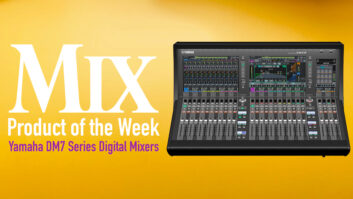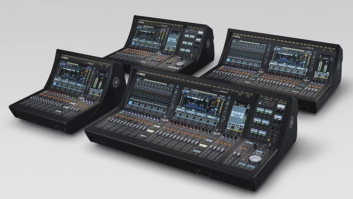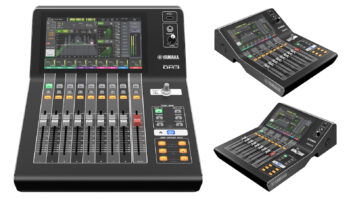There are many production companies that now have vast stockpiles of heavy old analog consoles; I know because my company is one of them. I may have been the last sound guy on the planet to embrace digital consoles though, now that I have, I am in a state of mixer bliss.
For the most part, all the companies that manufactured analog consoles now also manufacture digital consoles. We are witnessing a veritable digital console war out there, with each manufacturer adding goodies and features while dropping prices to unheard of low price points. One such manufacturer is Yamaha: they were pioneers in this digital market and continue to pave the way with new consoles. In this review, I will discuss the CL Series.
Features
For this review, I was provided with the CL1, an 18-fader console with touch-screen menu operation, 48 inputs plus 8 stereo inputs, and 35 outputs (24 mix outs, 8 matrix outputs, L/R, and mono). Its OS is quite reminiscent of the M7CL,with many identical features and operations but is loaded with much of the functionality of the PM5D, and then some. The console comes preloaded with initial data settings that allow for a quick start.
Relative to larger digital consoles like Yamaha’s own PM5D, the CL1 takes up very little room in the truck. It weighs in at 51 pounds and is roughly 2 feet wide, 2 feet long and 1 foot tall at its rear.
The CL1’s surface is laid out cleanly–functional and not too busy. The cool thing about CL in this regard is that it allows users to set up the Fader Banks how they wish. There are three fader banks: A—on the left and under the touchscreen in the Centralogic section—or B, with the two faders on the right in the master fader bank. In section A, users can quickly access inputs 1-48 & ST inputs (in banks of 8), DCAs 1-8, or a custom layer that can consist of inputs, output masters, and DCA masters.
In the Centralogic Fader Bank B, users can either select between having inputs 1-48 or three different sets of custom faders. With the push of a button, fader bank B changes to outputs; users can easily access DCA Masters, Mix and Matrix masters, as well as ST inputs and another three custom fader banks. This arrangement of layers and fader banks allows users to have any input, output, or DCA in any fader bank of choice. All channels can be labeled and color-shaded from an internal naming source, an on-screen keyboard, or from the free StageMix iOS app, allowing for quickly identifiable groups of faders. The B fader bank is directly accessible via touch screen, thanks to Yamaha’s Centralogic operational system.
Each fader on the console is selected by depressing the key above the fader, which illuminates to remind users of the channel up for adjustment. Once the channel is selected, complete access to the channel’s on-screen Selected Channel is available. The CL1 offers a nice set of channel control options with parametric EQ, comp/gate/expander, de-esser, compander, and ducker for the 2 insert points and input delay and 24 Mix sends. Inputs can also be routed directly to matrix outputs so CL series consoles can be used as monitor console with 32 mixes.
The CL1 has a nice selection of “rack” items, including 32 insertable graphic EQs, allowing the console to be used for monitor mixing applications. The effects package is nicely arranged with a variety of reverbs, delays and other effects. This rack is an 8-space rack; think of it as having 8 effects engines.
The back panel offers 8 omni inputs and 8 omni outputs for local I/O including inserts, as most of the I/O is accessed through the complementing stage racks. The R series rack units consist of 4 different configurations: Rio3224-D (32 mic/line ins/16 analog outs + 4 AES outs), the Rio1608-D (16 in/8 out), the Ri8 (8 ins), and the Ri8, an 8-channel output box; all connect via CAT5e or CAT6 and utilize Dante as the audio network for transporting audio and control to/from devices on the network. There is also a provision for external word clock, GPI, MIDI in/out, and an AES output as well as 3 MY-card slots, and an external power supply connection.
In Use
The CL1 arrived at my office in time to take it for a stint at a contract casino gig; I’ve provided full audio there for 20 years. This day, the act was classic country artist John Anderson (“Seminole Wind”). I used the console as the monitor desk; the artist needed nine mixes for his full band.
I did most of the show’s preset details at our shop, delving into the naming and coloring menu, setting up monitor mix masters in cool pink and inputs in sky blue. Naming the channels was quite easy using the touchscreen keyboard. I proceeded to name the 29 inputs, which took me 15 minutes to do. I preset the masters, the effect returns and sends, inserted graphic EQs on the masters and set the reverb parameters—all in about 30 minutes—and then saved to the internal Scene menu as well as to my own flash drive via the front panel USB point.
With the console set, I packed, shipped and unpacked, using Cat 5e to connect the Rio to the surface and our copper snake fanout from our main splitter head to the CL1’s provided Rio stage box. I continued on to the “ring-out” portion of the day, settling in the monitor wedges via the CL1’s on-board graphic EQs that had been inserted into each of nine mixes. The adjustment of the EQ can be done by touch screen or by fader assign, which I preferred.
When mixing monitors on CL1, I have the option of adjusting volumes via either fader by fader flip key (referred to as Sends On Faders, or the actual hard surface aux sends. I found the use of the hard surface rotary sends to be the most expedient; to me, the fader flip method adds an additional step to a simple process. Though fader flip allows for quick visual representation of the various channel levels in a given mix for quick reference, in general, using the rotary sends resembles the operation of a typical analog monitor mixing style, with which I am very comfortable.
Summary
I found the CL1 to be a good-sounding, comfortable feeling, and very useful console, built like a Sherman tank. The EQ section is quite responsive, the comps and gates are friendly, the operating system is intuitive, and the overall usefulness of this console on a pro concert level is very good. As with other new digital desk offerings, the amount of internal goodies has gone up exponentially, while the price tag is certainly more affordable. The CL1 is a serious live digital console, useful on the simplest of levels as well as by higher end concert professionals.
Price: from $15,000 (MSRP, console only)
Contact: Yamaha Commercial Audio | http://www.yamahaproaudio.com/global/en/products/mixers/cl/







